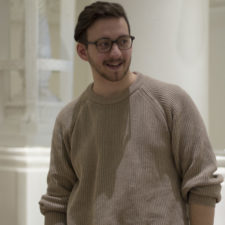Janice Lee’s “The Sky Isn’t Blue” (Civil Coping Mechanism, 2016) is a gorgeous collection of lyric essays exploring the ways that space and poetry coalesce. Each section of the book examines a different location and all of the associations, thoughts and emotions that have manifested within it.
In the first section (titled “Salton Sea”), Lee explores her memories of and relationship to a certain image: the dead fish. She creates an assemblage out of the fish and the abstractions attached to it. The product of this process (the assemblage) is a beautiful piece of writing that is both honest and otherworldly. “Too, the murmur of a dead fish, the endless wonder locked in an image that is a thing in a place.” The fish becomes a medium to project other images, the body of water from which further ideas will surface. From the image of the dead fish, Lee finds herself examining the strange movements of time and what it means to be a person.
The essays throughout this book tend to fluctuate in form, sometimes looking like paragraphs and sometimes looking like lines of poetry. The language itself occupies space in a melancholic and distant way. When a paragraph ends and it’s preceded by poetry, the page begins to open up as the words grow farther apart. This fluctuation really had me noticing the amount of empty space on each page. This emptiness accentuated the inherent poetry that space is capable of containing and the effect that this inherent poetry can have on the reader.
I think that we can define Lee’s work here as a kind of “poetic territorialization” where the poem acts as an assemblage, constructed by the multiplicity of objects in a space. In other words, the poem is made from its surroundings (both physical and abstract). It is something to be extracted or witnessed. “The poetics of space has to do with articulating the inarticulateable,” Lee says. It is the examination of minutiae or the discovering of images hidden behind a facade. The familiar as it is stripped of its signification. The thingness of our surroundings.
In the second section of Lee’s “The Sky Isn’t Blue,” we see the ways in which the bed (and the surrounding room) become poetic. The physical space is made up of objects: the bed, the window, the floor, the ceiling. The abstract space, which lays itself over the physical like a blanket, is the significance of these objects. The objects of the bedroom are imbued with meaning. Each contains old memories and passing thoughts. The anxieties of being are found manifested in the everyday mundanity of this environment.
What this implies is that the poet is not the contents of a poem. The poet is the builder of the assemblage and the parts of the assemblage are taken from these physical and abstract spaces. The bedroom poem is made from the components of a bedroom. It is the “house unfastened.”
In creating this assemblage there are certain areas of difficulty. Lee asks herself how to write a space, how she can linguistically represent or mime these environments. And the truth is that this tool is inadequate. Language cannot do what we want it to, what we at a young age assumed that it could. The incomplete and vague nature of language has made this act of assembling difficult and risky. The act of writing a space is never comprehensive. The entire space cannot be contained. Here, Lee searches for ways to contain the parts of a space by using her own personal relationship to it.
“The Sky Isn’t Blue” is a series of assemblages, made out of various locales (like the bedroom or the Salton Sea) and the parts of Lee’s being that are tied to them. It is a discussion of the poetics of space, and an example of how space occupies and informs poetry. Janice Lee has made something incredible and ambitious, something certainly worth reading and learning from.

Mike Corrao is a young writer and filmmaker working out of Minneapolis, where he earned his B.A. in film and English literature at the University of Minnesota. In 2016 he was an artist-in-residence for the Altered Esthetics Film Festival. His work has appeared in over 20 different publications, including Entropy, decomP, Cleaver, and the Portland Review. His first novel, Man, Oh Man will be released from Orson’s Publishing in the fall of 2018. Further information can be found at www.mikecorrao.com.


0 comments on “Poetic Territorialization: Reading Janice Lee’s The Sky Isn’t Blue”